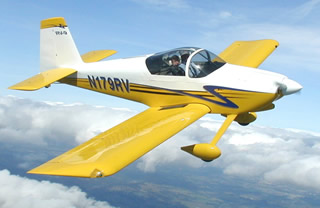Why the RV-9A?
 The -9A is a fast plane that lands nice and slow. It can carry two big passengers and a mess of baggage. It has a 700 mile range on a tank of gas, and it can cruise at 180 miles per hour. It is easy to fly and looks great. It is not intended for aerobatics, but is optimized for smooth cross-country flying. It is a real airplane that can be built for not a lot of money. It is exactly what I wanted. The -9A is a fast plane that lands nice and slow. It can carry two big passengers and a mess of baggage. It has a 700 mile range on a tank of gas, and it can cruise at 180 miles per hour. It is easy to fly and looks great. It is not intended for aerobatics, but is optimized for smooth cross-country flying. It is a real airplane that can be built for not a lot of money. It is exactly what I wanted.
Flies Fast - I want to go three times as fast as a car! The RV-9A will cruise at 180mph. Wow!
Lands Slow - The slower a plane can fly without stalling, the better. Typically fast planes are difficult to land. The RV-9A lands at about the same speed as a Cessna 150.
Two Seats - Although I had considered building a four seat plane like the RV-10, I decided that the majority of my flying will be by myself or with only one passenger. Besides, a big plane costs more money. I have sat in the -9A demonstrator, and there is plenty of room for two big guys like myself.
Large Baggage Area - In addition to two passengers, there is plenty of room for nearly 100 pounds of baggage. This is probably more important to my wife.
700+ Mile Range - The plane is really optimized for cross-country travel. The fuel tanks hold a combined 36 gallons of fuel, which will allow me to fly for four hours with reserves.
Easy To Fly - The -9A has a specially designed wing that just wants to fly. The extra wing area means that the glide ratio is extremely generous. It also means that there is more time to find a suitable landing spot if the engine decides to quit.
Looks Great - You have to admit that the picture above is a lot cooler looking than the picture of the Cessna 150 that I trained in.
Not Aerobatic - Here is the tradeoff. To get this really great cross country capability, fast speed, and slow approach speeds, you have to give something up. That thing is aerobatics. I'm not an aerobatics sort of guy, so this is a tradeoff I'm willing to make.
Not Expensive - This is a major issue for me. I am not able to spend a lot of money on a plane. Furthermore, I didn't have a lot of up-front money to invest.
How much will it cost?
I know that most people think that if you own an airplane that you must be rich. These are probably people who buy a new $35,000 SUV every four years. I have decided to drive my 12 year old Honda for a couple of more years while I build this airplane. People make choices. This is my choice. Van's sells their planes as "subkits" that you buy one at a time. The first one is about $1600 and takes a few months to complete. The final three kits are each about $5,000 each, and most people spend about six months on each of these kits. So, if you can figure out a way to save your money so that you can buy the kits as you need them, you can sort of "finance" your kit purchase. I look at it as "sweat equity" in the plane.
Naturally there are some "additional items" that must be purchased in addition to the kit. These items include an engine, propeller, some instruments, a radio, a transponder, electrical components, lights, paint, and interior. You can spend just about any amount of money on these items. I am rebuilding an engine, which will save me some money. I will be fairly conservative in the "bells and whistles" I put in the instrument panel, although I do plan to install an EFIS. I will fly the plane before I paint it. I will add more costly avionics later. What this all means is that I will be able to postpone some of the more expensive additions until a later date.
The bottom line cost-wise is that a VFR-equipped RV-9A can be built for about $35,000. When completed, it is valued at more than twice that amount. Try selling your old SUV and then let me know if you get twice the amount you paid for it! Of course, you probably didn't build your SUV. Next: Instrument Panel Considerations
|

